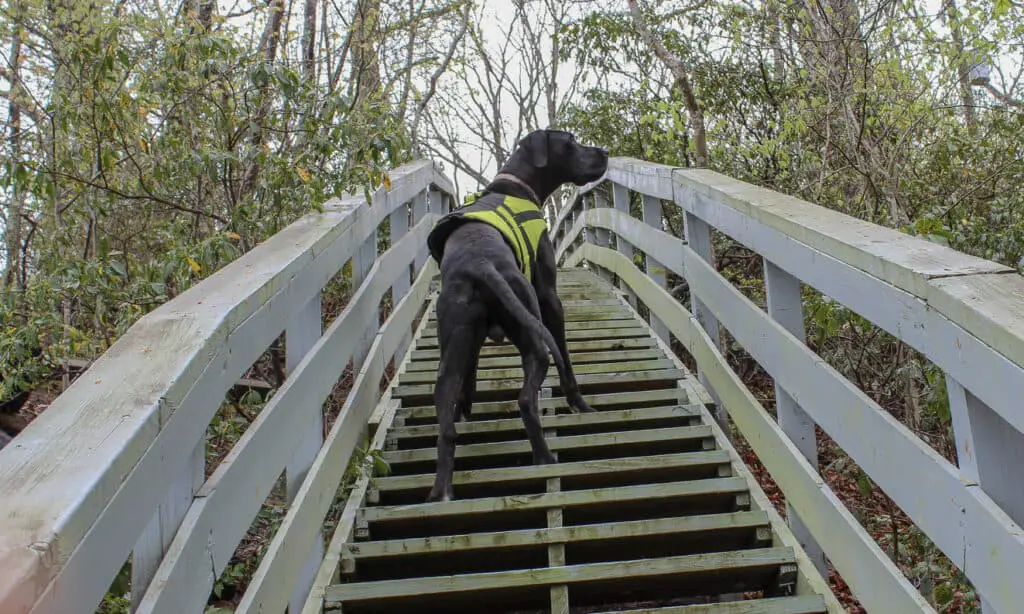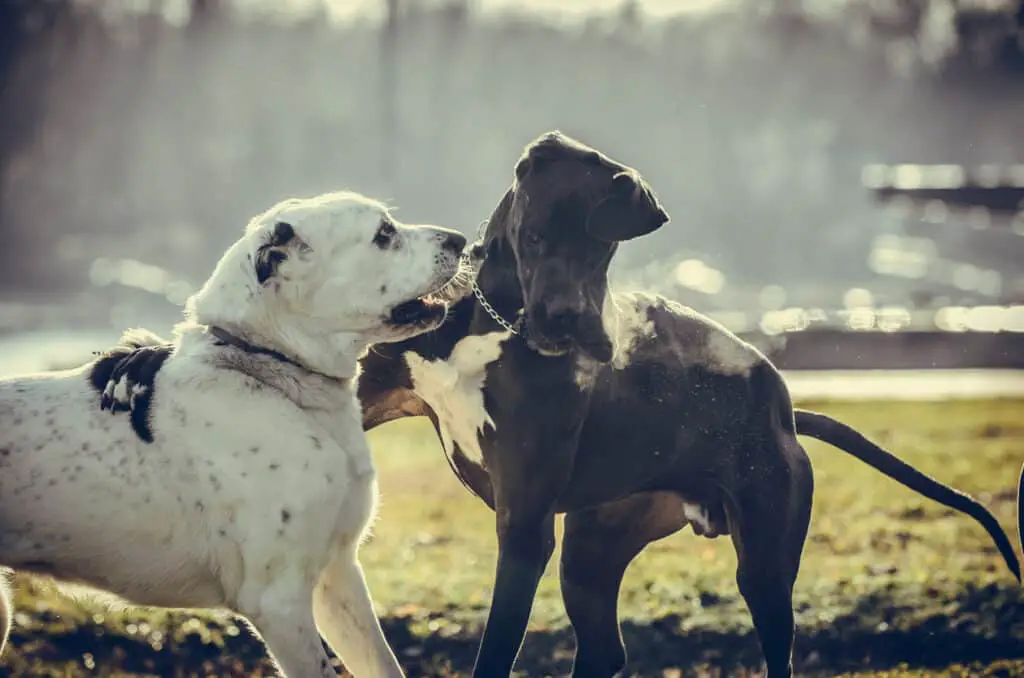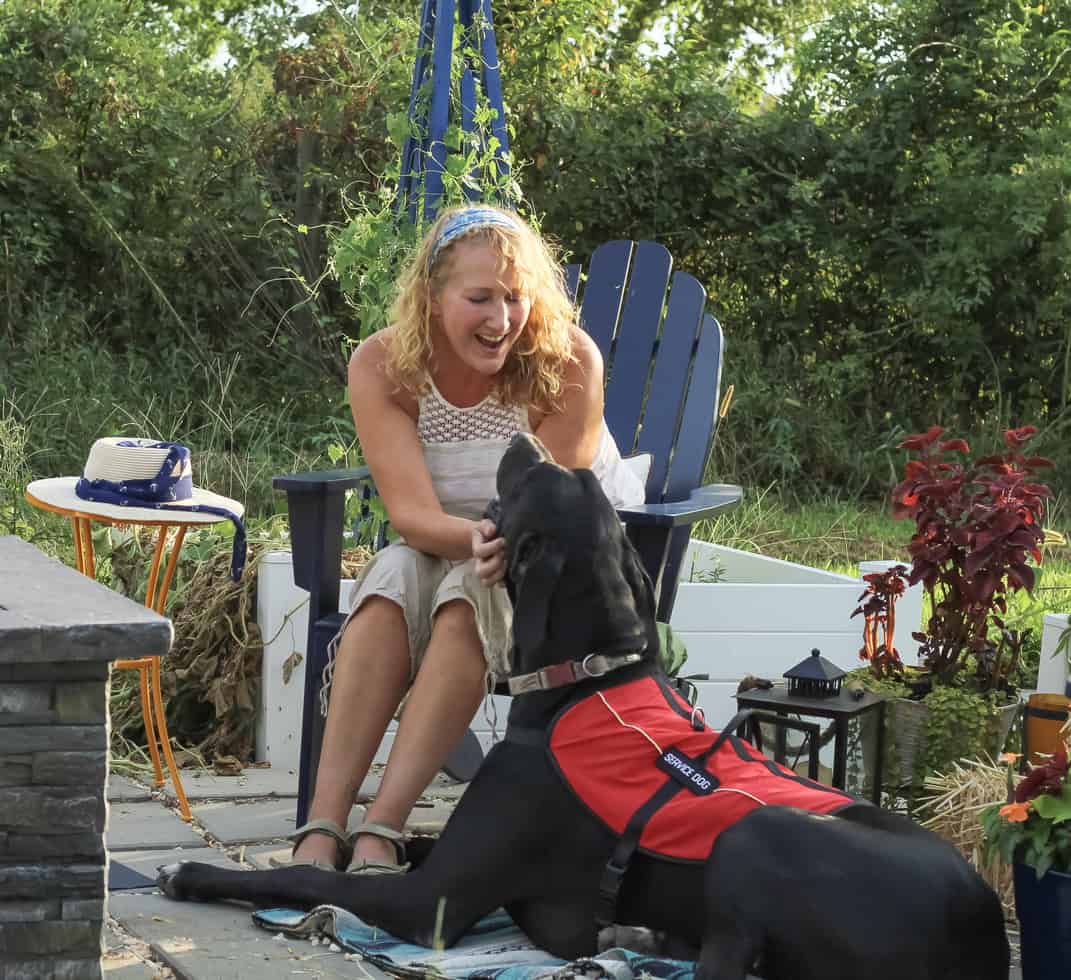Great Danes are a popular family pet and beloved within the animal community for their loving and devoted nature. Easily recognized by their regal bearing and thanks to popular television shows such as Scooby Doo, Great Danes are popular companions for many reasons, but they also have the capacity to be more than mere companions.
Great Danes can be great service dogs, however they must be trained by a professional. They offer great mobility assistance and can be trained to retrieve things high off the ground.
What is a service dog?

The U.S. Department of Justice defines a service animal as “a dog that has been individually trained to do work or perform tasks for an individual with a disability.” In order to qualify for this definition, the task(s) performed by a service dog must be directly related to the disability of the person they’re serving. Accordingly, since March 15, 2011, dogs are the only animals that are recognized as service animals under titles II and III of the Americans with Disabilities Act (ADA).
There are several types of service dogs, and there is also a distinction between service dogs, therapy dogs, and emotional support dogs. Types of service dogs include the following:
- Guide service dogs are also known as seeing-eye-dogs. These dogs help people who have lost or have severely impaired vision navigate the daily world. Some examples of assistance guide dogs perform include: avoiding obstacles, opening doors, assisting with descending curbs or crossing roads, and generally helping with balance and mobility. This type of service dog was the first officially recognized type.
- Hearing service dogs help their deaf handlers navigate the world by communicating sounds via touch, often with a nudge. In this way, they alert their owners to important noises such as smoke alarms, doorbells, phones, someone verbally calling the handler’s name, or other scenarios where a timely reaction is necessary.
- Medical alert service dogs are able to help people suffering from health conditions such as epilepsy cause regular seizures. In many cases, they are able to alert their handler moments before an episode occurs, thereby ensuring the person is not caught unawares. Service dogs in this category can also work with diabetic individuals by letting them know when their blood sugar is low, or by seeking medical assistance if necessary.
- Mobility assistance service dogs are typically larger breed dogs due to the physical nature of their work. These dogs assist people who have sustained injuries that make walking, standing, or balancing difficult. In many cases, these injuries are related to the spine or leg. In addition to providing balance support, these dogs can open doors, retrieve items, and adapt quickly to evolving circumstances. These dogs often assist individuals with Multiple Sclerosis, Cerebral Palsy, or Parkinson’s Disease.
- Psychiatric service dogs specialize in assisting people who live with mental illnesses. These dogs undergo specialized training that is adapted to their particular handler’s needs. For example, a veteran suffering from PTSD would benefit from a service dog in this category who is trained to remind them to take any prescribed medication and provide calming touch.
Difference between a service dog and a therapy dog

The main difference between a service dog and a therapy dog is the more generalist profile of a therapy dog. Therapy dogs are chiefly responsible for providing comfort, and any type of dog may be recognized as a therapy dog. Recognition as a therapy dog does require special training and the passage of the American Kennel Club (AKC) Good Citizen Test (CGC), which requires mastery of ten basic skills. Additionally, owners volunteer their dogs as therapy dogs, but the animals don’t stay with the people to whom they provide comfort during the day.
They return home with their owners. In addition to its being required in order for a dog to be recognized as a therapy dog, the CGC is also recommended for owners looking to lie a strong foundation for
Psychiatric service dogs and emotional support animals (ESAs)

The key difference between a psychiatric service dog and an emotional service dog is that the former is a recognized service animal under the ADA, while an ESA is not. Psychiatric service dogs must undergo specialized training and be recognized for the service skillset they provide their handler, and these dogs may only be acquired after a consulting with a psychiatric professional who diagnoses a disability and prescribes a service dog.
Due to their certified status as a service animal, dogs performing psychiatric services for their handlers have a federally protected right to accompany their owners virtually anywhere they go, including business establishments, schools, non-pet friendly housing, on airplanes and trains, and other places.
ESAs, on the other hand, do not enjoy the same rights to accompany their owners wherever they might go. The reason for this is because the threshold for a dog to be recgonzied as an ESA is much lower, requiring only a letter of recommendation from a doctor that recognizes that the dog provides some mental and emotional benefits to the owner. In addition to dogs, cats and other animals may receive recognition as an ESA.
Misrepresenting ESAs as service animals is a problem in the United States. It is such a problem that more than 20 states have made it illegal to misrepresent an ESA as a service dog, such as by simply purchasing a service vest and putting it on one’s dog. The reason this is irresponsible behavior is because it gives service dogs an undeserved bad reputation.
So, can a Great Dane be a service dog?
Great Danes make excellent mobility assistance dogs. Their size is an obvious factor in this accolade, but less obvious is their natural affinity for adapting to novel situations. This type of intelligence is known as adaptive intelligence, and it is an aspect where Great Danes shine, although their overall intelligence is only considered average. However, they are also considered trainable and are highly sensitive, making them great candidates for servicing handlers that may physically struggle in different ways on any given day.
The Great Dane’s highly sensitive nature also makes them excellent psychiatric service dogs. Naturally loyal and protective, they can be trained to recognize when their handler is in emotional distress and provide the appropriate response based on the situation.
Great Danes also have goofy an loveable personalities, essentially, great dispositions for people who struggle with their psychiatric health. The Great Dane’s zest for life and natural curiosity make them excellent, big-hearted companions. Although not typically associated with the term “service dog,” Great Danes have been gaining in popularity as a service dog in recent years.
Most popular service dog breeds in the US by category
- Labrador Retriever
- Golden Retriever
- German Shepherd Dog
- Poodle
- Bernese Mountain Dog
- Collie
- American Staffordshire Terrier
- Pomeranian
- Great Dane
How to know if you need a service dog
To be eligible for a psychiatric service dog, you must consult with a licensed mental health professional. If you believe your or someone else’s physical disabilities qualify for a service dog, a doctor must be consulted to obtain the necessary referral. After you obtain a referral, you may commence your search for an appropriate service dog in earnest. At this stage, consulting with a professional such as a veterinarian may be a wise idea, as vets will be able to provide guidance based on your needs.
How to choose a service dog breed
Choosing a service dog breed should not be simply based on what type of breed you’re drawn to or simply like best. If you are in need of a service dog, the best service dog for you will be the one who is best able to meet your demonstrated needs.
Is a Great Dane a good service dog for you?
However much you may love this breed, it is important to view your needs in a service animal as objectively as possible so that you can make the right choice for your particular situation. Great Danes can make wonderful service animals in many situations, such as by providing mobility or psychiatric support, but there are other environmental factors to take in before making a final decision.
Things to consider when evaluating a Great Dane as a potential service dog
While Great Danes have many wonderful characteristics and attributes that make them great service animals in some capacities, even in the best-fit scenario, there are some downsides to carefully consider.
Cost of purchase
Great Danes are extremely expensive animals own. If you decide to purchase a Great Dane puppy to raise for service purposes, it’s essential to work with a reputable and trustworthy breeder in order to mitigate the risk of acquiring a puppy that will succumb to one of the many health risks the breed is known for. By conducting due diligence, you are investing in the long-term health of your service dog, but this investment certainly comes at a cost. A purebred Great Dane puppy will cost anywhere from $600 to $2000.
A couple tips on navigating the costs associated with acquiring a Great Dane
- In order to mitigate the up-front cost, you can learn about Great Dane colors and focus on choosing one that comes from a healthy gene pool but does not have a coat color meeting any of the seven color standards by the American Kennel Club. Choosing a Great Dane puppy that does not qualify (or does not well qualify) for dog showing can provide you with a negotiation tool regarding the cost of the puppy.
- You may also consider adopting a Great Dane from an accredited rescue, however it should be noted that adoption carries with it different risks. Namely, it is not always possible to know the full backstory of the dog you’re adopting, so working closely with shelter staff will be critical to ensure you are matched with the correct Great Dane for your service needs.
Cost of ownership
An adult Great Dane will need several cups (around 2,500 calories’ worth) of food per day, and if you purchase one as a puppy, their food intake will need to be carefully monitored and regulated so that they do not grow too quickly. An exacerbated rate of growth can be detrimental to the long-term health of your Great Dane, which in turn can result in costly veterinary trips and procedures.
An important financial factor to keep in mind: On average, Great Danes will cost their owners somewhere in the neighborhood of $20,000 over the course of their life.
Short lifespan
One of the primary drawbacks of this magnificent breed is its depressingly short lifespan. On average, Great Danes live only 7-10 years, and it is not uncommon for them to succumb to one of the many illnesses they’re predisposed to.
Great Dane’s size
Although their size is a definite asset in the context of providing mobility service, Great Danes are unable to begin training for their service role until after 18 months of age. The reason for this is related to the prolonged growth phase that Great Dane puppies experience; their skeletal frames are simply too fragile to undergo sustained and rigorous exercise or demands of any kind. Additionally, their size requires them to be near-perfectly trained, or else they risk accidentally harming the person they’re meant to service due to their sheer size and strength. In conclusion, while Great Dane have many wonderful attributes that may make them the ideal service dog, it is important to carefully factor in individual circumstances before making a decision.

